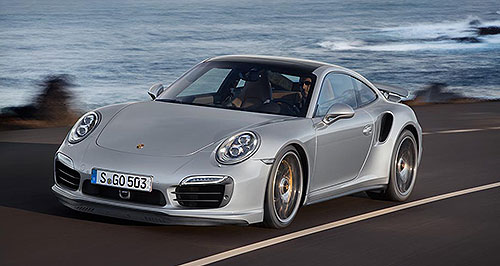Future models - Porsche - 911 - TurboPorsche premieres more potent 911 TurboPeak Porsche: The new 911 Turbo has wider rear haunches, and even more pace than before - try 0-100km/h in 3.1s on for size. More poke plus four-wheel-steer for new 911 Turbo – but farewell to manual gearbox5 May 2013 PORSCHE will unleash the vicious new-generation 911 Turbo, and its even more extreme Turbo S sibling, on Australia by early 2014. The new model seen here for the first time is larger, faster, more powerful and packs more race-bred technology than ever before, and is poised to leap straight to the top of the 911 range. But prospective buyers who like to shift their own gears will be disappointed, because unlike 911 Turbos of yore, no manual gearbox will be offered. Instead, a seven-speed PDK dual-clutch automatic transmission becomes the sole option. Power comes from a 383kW bi-turbo version of the familiar 3.8-litre flat-six – up from 368kW on the old version. The even harder S gets 412kW, compared to the old model’s 390kW. The standard ‘sound symposer’ is said to intensify the driving experience by feeding the turbo engine’s induction sounds to the passenger compartment via a dedicated speaker. Typically, it may not have the stylistic flair of an Italian supercar, but it sure has the pace. The regular Turbo accelerates from zero to 100 km/h in as little as 3.2 seconds, while the S does the dash in 3.1s. Top speed is 318 km/h. Features such as idle-stop, plus the more frugal PDK, cut fuel use by a claimed 16 per cent. Porsche reckons 9.7 litres per 100km on the combined cycle is achievable. Again, power is sent to all four wheels via a new AWD system with electronic multi-plate coupling and water cooling that helps it direct more torque to the front wheels if required. Features include the aforementioned AWD, plus active rear-wheel steering (as with the normally aspirated 911 GT3 track-racer unveiled in March and also due here by early 2014 at the latest). An active anti-roll system, dynamic engine mounts and ceramic brakes help the Turbo S lap the northern loop of Germany’s famed Nurburgring in “well under” 7 minutes and 30 seconds. But whether it can match the Nissan GT-R’s controversial 7min 19.1s time is less clear – this figure previously sparked a bitter war of words between the German marque and its cut-price Japanese rival. A three-stage extendible front spoiler and a three-position moveable rear wing improve downforce, in tandem with the new active anti-roll system. Stylistically, the rear haunches are 28mm wider than the regular Carrera 4’s already widened body (compared to the previous model), and the Turbo gets unique forged 20-inch wheels with central hub locks. The Turbo S gains new full-LED headlights that feature four-point daytime running lights and dynamic, camera-based main beam control. Despite its bigger dimensions, the use of more aluminium is expected to see the new cars hit the scales under the 1570kg of the old 911 Turbo – improving power-to-weight ratios. As with the new GT3, the Turbo twins get new rear axle steering, which consists of two electro-mechanical actuators instead of conventional control arms on the left and right of the rear axle. The steering angle of the rear wheels can be varied by up to 2.8 degrees, depending on vehicle speed. At speeds up to 50 km/h, when the front wheels are turned, the system steers the rear wheels in the opposite direction to the front hoops. Porsche claims this corresponds to a “virtual shortening” of the wheelbase by 250mm, and helps low-speed manoeuvres and practicalities such as parking. At speeds above 80 km/h, the system steers the rear wheels in parallel to the turned front wheels. This is said to be equivalent to a virtual lengthening of the wheelbase by a significant 500 mm and gives the sports car “tremendous stability”. Both the Turbo and Turbo S get subtle interior updates over their regular 911 siblings, with standard Bose audio and an optional Burmester system. Radar-controlled cruise control, camera-based road sign and speed limit recognition will also be offered. Local pricing will be revealed closer to launch, but for point of reference, the old model cost from around $360,000 when it arrived in 2010.  Read more911 pricing
Motor industry news |
Click to sharePorsche models911 pricing
Motor industry news |




























Facebook Twitter Instagram